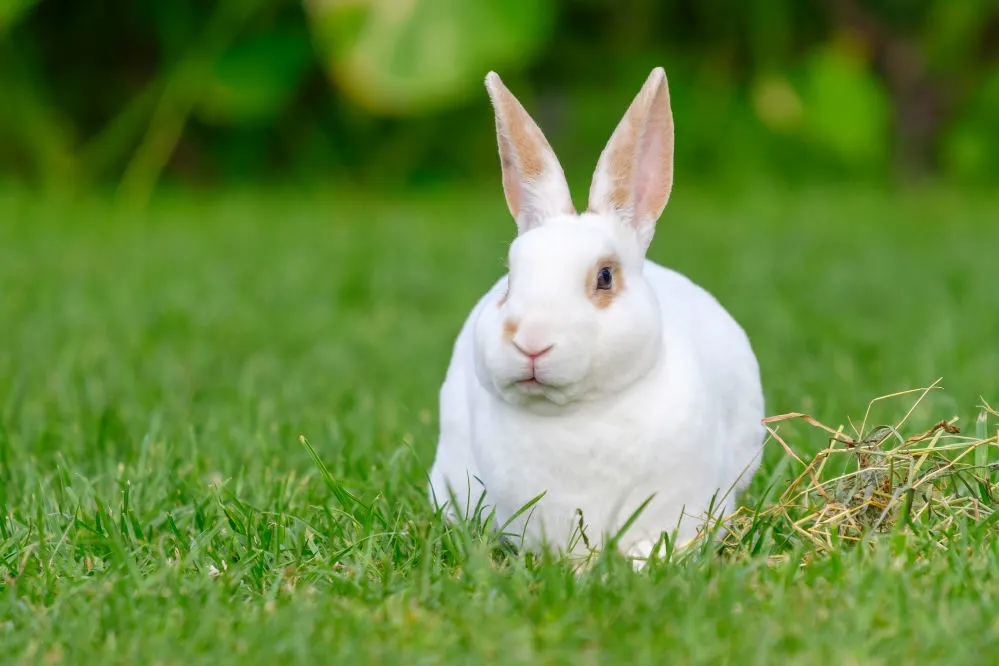If you’re a new pet bunny owner, you probably wonder, “How many times a day should I feed my rabbit?” Stress no more. This handy guide will take you through everything you need to know.
Your adorable little fur ball has quite the simple diet — fresh hay, water, grass, leafy veggies, pellets, and the occasional fruity treat. It should essentially mimic a wild rabbit’s diet. So, you should try to feed your indoor rabbit foods they would have eaten in the wild.
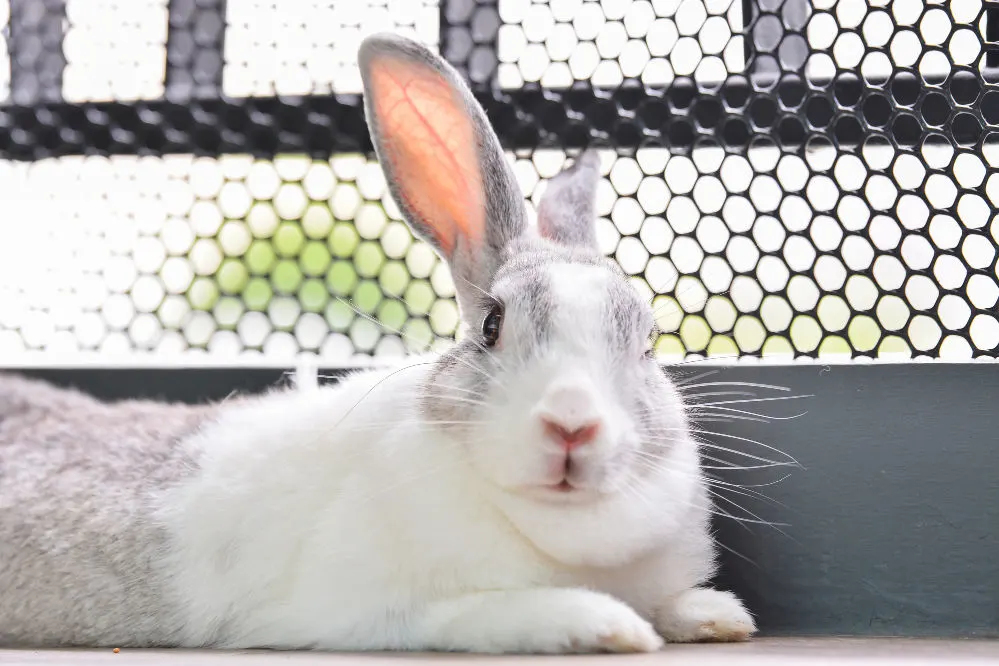
However, this is not always easy to figure out, so a deep dive is needed. How many times a day you should feed your furry friend veggies, hay, water, etc., will be covered in detail.
By the end of this post, you’ll be a bunny expert. So it’s time to dive into this rabbit hole.
How many times per day should I feed my rabbit?
How many times per day you feed your rabbit will depend on their age, size, and types of food. However, it’s still tricky to determine this, as you’ll notice that rabbits rarely stop eating. That’s because they are grazers, meaning they’ll munch away continuously.
This is a result of a rabbit’s digestive system moving constantly throughout the day. So, it’s best to try and give your bunnies an unlimited amount of grass and hay. If that’s not possible, then aim for a daily bundle of grass or hay that’s about as big as them.
Besides grass and hay, which is the main diet of a wild rabbit, you can go ahead and feed your bunny fresh foods, pellets, and occasional treats. Let’s have a closer look:
Grass and fresh hay
Roughly 80% of your rabbit’s diet should be grass or hay, which means unlimited access to portions about the size of your rabbit. High-quality grass hay is the most essential part of a rabbit’s diet. Timothy hay, and oat hay are all excellent options. You shouldn’t give your adult rabbit alfalfa hay: it’s too high in calcium.
Providing unlimited hay will ensure your house rabbit’s needs are met, as these are excellent sources of fiber. Alfalfa hay is good for younger rabbits but not essential and should be limited or completely removed from an adult rabbit’s diet.
Pellets
A quarter cup to half a cup of pellets, depending on the rabbit’s size, will be enough to add to a balanced diet. This is about 4% of the daily diet. For more accuracy, aim to feed them 0.88 ounces (24.94 g) of pellets per one lb (0.45 kg) of your rabbit’s body weight.
Commercial pellets have some fiber and have plenty of nutritional value when fed in small quantities, as suggested above. Typically you’ll want to feed timothy hay pellets to your rabbit, unless they’re still growing. Then, you can replace it with timothy hay pellets once your rabbit reaches adulthood.
Fresh vegetables
The ideal diet for rabbits contains about 15% of leafy green vegetables. That would be around one to two cups, or 0.5 lbs to one lb (0.22 kg to 0.45 kg) daily, ranging from one cup for smaller rabbits to two for larger rabbits.
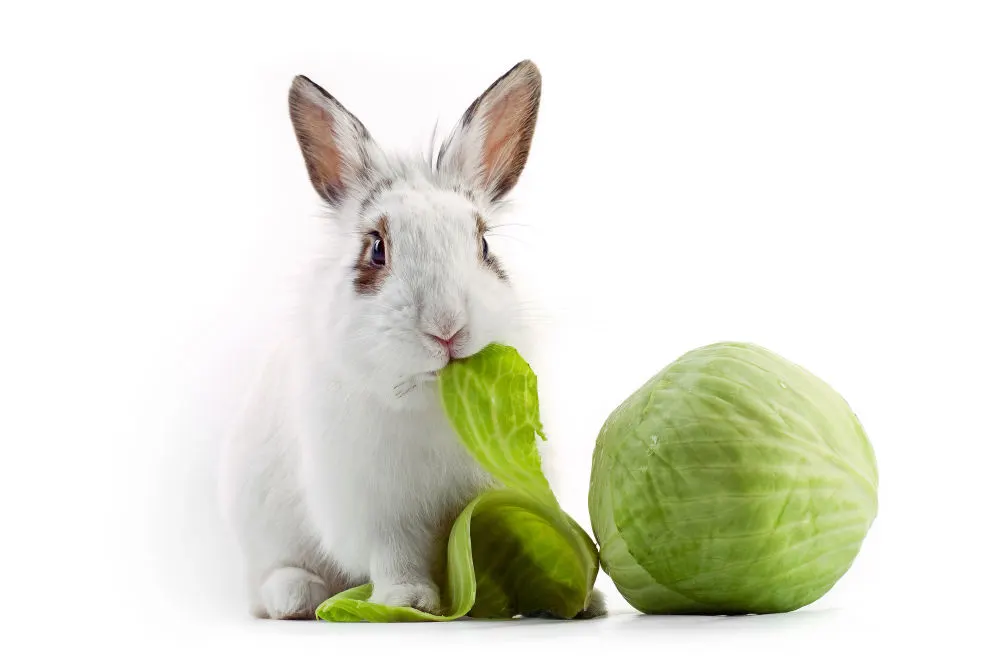
Give your bunny fresh leafy greens like bok choy, romaine lettuce, mustard greens, beet greens, broccoli greens, watercress, basil, and carrot tops. Be careful with some greens like kale that can be higher in calcium and lead to certain bladder stones.
Fresh fruits
Fresh fruits should be seen as a special treat that you can give your fluffball about once per day to once per week. Fruits like apples (without seeds), bananas, berries, grapes, watermelon, and avocado are considered treats.
If you want to give your pet rabbit fruit on a daily basis, then try to limit the portions to one to two tablespoons. This would make up roughly 1% of their daily diet.
You don’t want to give your pet too much fruit due to its high sugar content. Too much natural sugar can cause digestive problems, leading to many other medical conditions like obesity, dental problems, and GI stasis.
So as a general rule, it’s best to stick with small amounts of fruits.
Fresh water
It’s okay for your rabbit to miss a feeding here and there, but ensure you always provide them with clean water. rabbits can also absorb water from fresh, juicy veggies and fruits.
However, that doesn’t mean you should skip giving your pet fresh water for multiple days in a row. Not enough water can lead to severe health and digestive issues. In fact, not having access to clean water for longer than a day can be fatal to rabbits, leading to complete organ failure.
Take note of any signs of dehydration, especially in summer. Look out for dry, hard fecal pellets, a poor appetite, dark-colored urine, thick saliva, and crusty eyes.
What should I consider when feeding my rabbit?
Certain factors may influence how often you should feed your rabbit. These include things like size, breed, and age.
Feeding sick rabbits
Sick rabbits have different dietary needs than healthy rabbits. So this will definitely affect how many times a day you should feed them. After visiting your local vet, you’ll be advised on what and how frequently to feed your rabbit if they have developed a sickness.
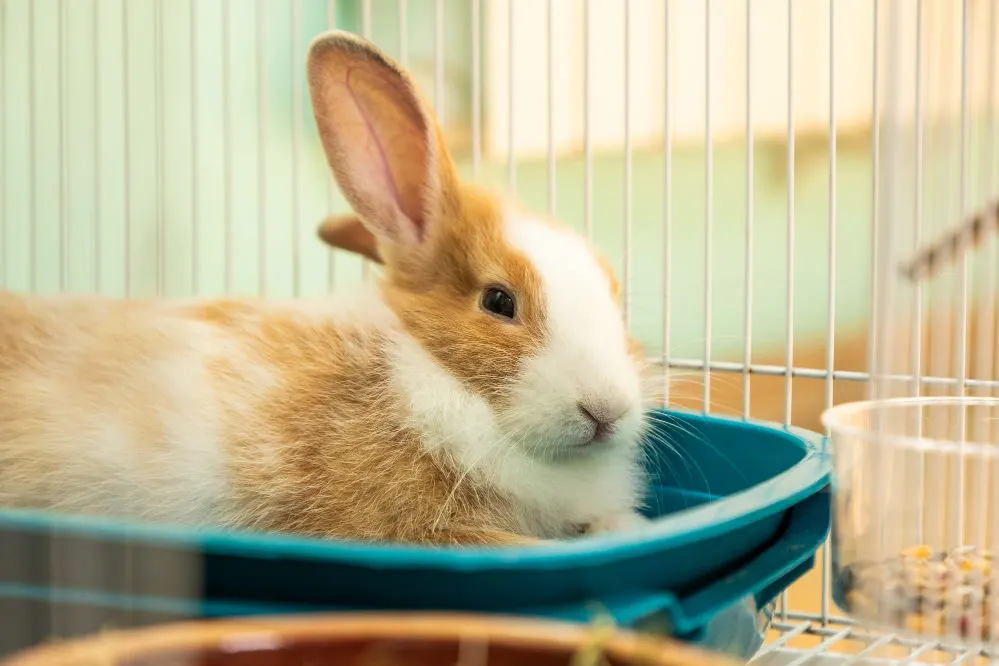
In most cases, you’ll have to force-feed your bunny through a syringe. Typically, syringe feeding should occur every two to six hours if your rabbit’s not eating solid foods. The frequency and portion size will depend on the type of food and water content prescribed by your vet.
The bottom line is that it’s always better to follow your vet’s orders on how to care for your sick furry friend at home.
Feeding baby rabbits (kits or kittens)
Newborn teeny-tiny buns are so adorable, and you wouldn’t need to worry about feeding them if the mother rabbit was around to provide them with milk. You’ll only start feeding them after they’ve been weaned.
However, younger rabbits have sensitive digestive systems, like human babies, and can’t digest the same amounts and types of foods as adult rabbits. You can start introducing new foods in your kit’s diet twice a day when they’ve reached two to three weeks of age.
If the baby rabbits are underweight and unhealthy, you can push for thrice per day. You can feed kittens good quality hay like alfalfa hay and young rabbit pellets and start introducing a variety of vegetables in limited quantities around three months of age.
Feeding according to the size of a rabbit
All rabbits should eat about twice daily for good health and have access to an unlimited amount of hay .
In general, the rabbit’s size does not have a significant impact on how many times you should feed them. It’s better to focus on the portion size, ensuring it matches your bunny’s weight and size.
Breed of rabbit
Since the feeding rate of rabbits depends on the maturity and size of your pet, it makes sense that larger breeds will eat more. But this only applies to portion size, as you can feed smaller or larger breeds the same number of times daily.
Pregnant does
Much like pregnant human females, a doe with a bun in the oven often requires larger amounts of food. You don’t always have to increase the feeding rate, but rather just the portion size. However, some pregnant animals do better with small meals more frequently.
Risks of overfeeding my rabbit
Feeding your rabbit way too much food can lead to serious health problems. Overfeeding can quickly lead to obesity which can be fatal for rabbits. This could negatively impact your rabbit’s gut health, risking the development of multiple complications that require medical treatments.
Not enough hay and an overfeeding of pellets can lead to obesity, as can too many sweet treats. Besides obesity, rabbits may also develop illnesses like diabetes and GI stasis.
Fortunately, rabbits can’t overeat hay, so you can feed it to them whenever. But they will consume way more veggies, pellets, and fruits if you do not provide lots of hay.
Risks of underfeeding my rabbit
The health of your rabbit can be at risk if you don’t feed your pet enough food or at the right frequency throughout the day. For example, skipping a day or two or just feeding your bunny once per day could cause serious health issues like hypoglycemia, gut blockage, liver disease, and dehydration.
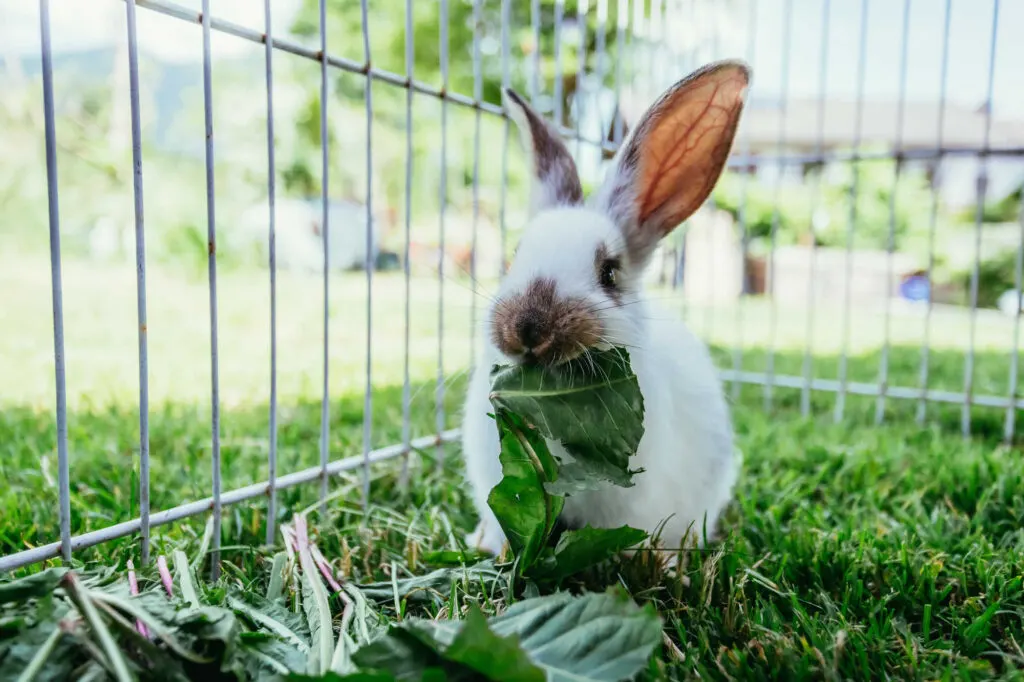
Note: If your rabbit hasn’t eaten for over 12 hours and is motionless and hunched, you should contact your vet immediately.
When is the best time to feed my rabbit?
It’s a good idea to try and feed your rabbit early morning, evening, and at night. As a rabbit owner, you’ll notice your pet’s eating pattern mimics how it would be in the wild. Wild rabbits have adapted to eat at times when predators aren’t around.
What should I not feed my rabbit?
There are numerous foods that come with giant red flags when feeding your pet bunny. Avoid giving your bunny these foods, no matter how curiously their adorable noses sniff at it.
Foods like chocolate, breakfast cereal, biscuits, bread, nuts, seeds, and grains contain too much sugar and carbohydrates for bunnies. Including too many carbs and sugar in your fuzzball’s diet may cause problems in the digestive tract and could damage your rabbit’s teeth.
Anything else I should know about daily rabbit feeding?
Since rabbits are inclined by nature to always munch when they’re not sleeping, it would be good to invest in chew toys. Doing so will help them develop strong and healthy teeth.
It also keeps you from possibly overfeeding your rabbit since you see them happily chewing away on a toy.
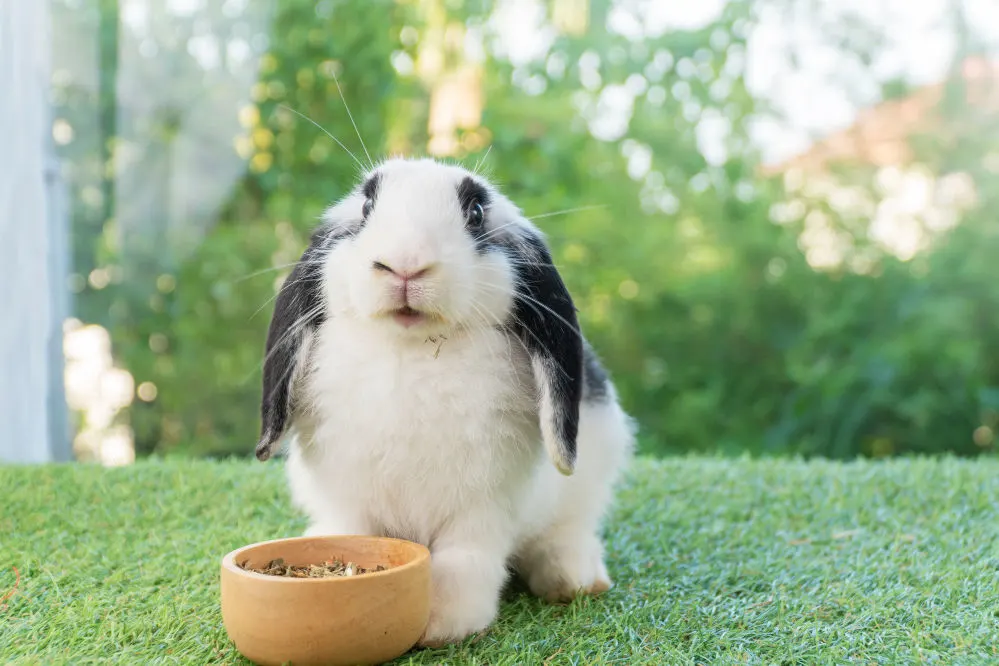
Cecotropes or “night droppings” also play an essential role in a rabbit’s healthy diet. To clear the air, these are nutrient-packed droppings resembling tightly bunched grapes that your rabbit reingests throughout the night. So, lucky for you, they make their own little “rabbit treats” that you don’t have to worry about feeding to your pet.
Rabbit feeding guide | Final thoughts
Now, you should have a good idea of how many times to feed your rabbit. Keep your rabbit’s age, size, and health condition in mind when feeding them daily. In general, feeding your furry friend the correct diet two or three times per day will suffice and help maintain their health.
As you can see, it’s not that difficult. If you’re still hesitant or see any red flags like your pet not eating, you can work with your local vet to figure out the ideal frequency of feeding. Don’t fret — you’ve got this!
Steph Dyson is a travel journalist by trade but a lover of all small pets. She’s been a pet mum to everything from gerbils to guinea pigs, rabbits to hamsters, and fish to dogs of all shapes and sizes. She wants to share her years of experience with small pets and make Small Pet Guides the go-to website for pet owners seeking information and care advice.

